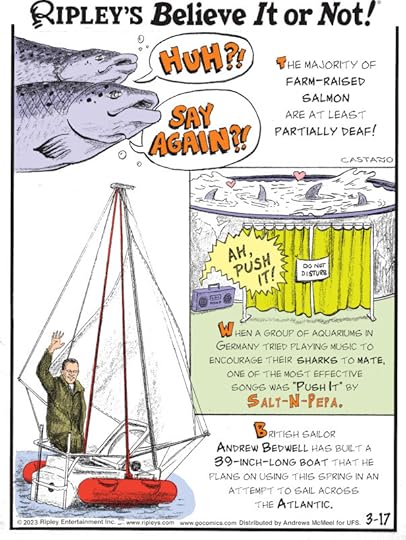Ripley Entertainment Inc.'s Blog, page 37
March 18, 2023
CARTOON 03-18-2023
March 17, 2023
A 92-Year-Old Has Been Tracking the Weather At NOAA for 60 Years
Featured in Ripley's Believe It or Not!

Lifelong Mainer, Arlene Cole has been working with the National Oceanic Atmospheric Administration (NOAA) and tracking the weather for almost 60 years! The weather observer, who is 92, considers the task “part of her life,” telling WGME, “I’ve always been interested in the weather. I grew up on a farm, and farm weather is very important.”
How It All StartedIn the 1950s, one of Cole’s friends worked as a weather observer for NOAA, and Cole took over the job after she died. Cole, who is from Newcastle, is one of over 8,700 volunteers in the United States who observes the weather and reports the information to the agency.
According to an interview Cole gave to the Maine Climate Council in 2022, she records the temperature and measures precipitation levels every day at 5 p.m. She sends her data, by mail, to NOAA’s National Weather Service (NWS) once a month.
For nearly 65 years, a Newcastle woman has been a weather watcher for the National Oceanic Atmospheric Administration, or NOAA.
Arlene Cole is 92 years old and still tracking the weather: https://t.co/MwIco8Wu2U pic.twitter.com/NdW4YBdFBj
— WPFO FOX23 (@FOX23Maine) March 9, 2023
In her briefcase is a record of all the weather conditions she has reported, which includes temperature, rain, and snow. Cole has steadfastly stuck to using a pen and paper to make her recordings, but she concedes that most of her fellow trackers, who are members of The National Weather Service Cooperative Observer Program (COOP), probably use computers.
Cole Can’t Be StoppedCOOP was established in 1890 to record temperatures, snowfall, and 24-hour precipitation totals “to define the climate of the United States and to help measure long-term climate changes.” Observational data from the volunteers was initially designed to “support forecast, warning, and other public service programs of the NWS.”
Believe It or Not!, Cole still has the original weather equipment from her friend in her yard, but she was recording temperatures for several years before she started working with NOAA. She explained, “I had a 5-year diary I had started in 1957 with my own thermometers. When Nancy Rawlings died in 1965, her husband Charles (Chuck) Rawlings suggested my name to NOAA.”
After Cole inherited the position, she would check the temperature outside every day. She received updated equipment in 1984 and currently keeps a receiver on her kitchen counter, which transmits the temperature from outdoors. She also uses two rain gauges, two white boards, a 24-inch measuring stick, and a 60-inch stake.
Cole records the high and low temperatures of the past 24 hours and writes down precipitation levels, if applicable. “If it happened when I was sleeping at night, I mark a wavy line when I estimated it occurred. I record the depth of snow on the ground, any fog, thunder, hail, or damaging wind,” she explained.
As for how long Cole plans on volunteering for NOAA as a weather tracker, she says she takes it “a day at a time,” aware that she may eventually have to pass the torch when she can no longer fulfill her duties.
By Noelle Talmon, contributor for Ripleys.com
EXPLORE THE ODD IN PERSON! Discover hundreds of strange and unusual artifacts and get hands-on with unbelievable interactives when you visit a Ripley’s Odditorium!Source: A 92-Year-Old Has Been Tracking the Weather At NOAA for 60 Years
CARTOON 03-17-2023
March 16, 2023
The Toilet-Shaped Plants That Thrive By Eating Poop
Featured in Ripley's Believe It or Not!

When nature calls, the toilet-shaped plants of the tropics work as the perfect bathroom for small mammals that call the forests home. In fact, by using the plants as a personal porta-potty the various mammals and insects are stimulating their own ecosystem and keeping the pitcher plants thriving.
Pitcher plants have made for a fascinating muse in the plant world as they shatter the very idea of what a plant is, eating others rather than being eaten. In fact, Charles Darwin himself was even floored by the carnivorous plant species writing in an 1860 letter to Charles Lyell, “I care more about Drosera than the origin of all the species in the world.”
Pitcher plants are truly some of the most intriguing species around. They’re known for their rather devious approach to capturing prey. Resembling pitchers (hence the name), they’re full of powerful digestive juices. When unwitting insects happen into the pool, perhaps attracted by a unique scent, they… well, they don’t tend to come back out again.
These potent plants can be very, very big, too. According to the New England Carnivorous Plant Society, the biggest pitcher plant on Earth is the Nepenthes Rajah. It can reportedly grow to three meters (almost 10 feet) tall!
That’s just the beginning of what’s so intriguing about the Nepenthes pitcher family, though. They seem to have developed a taste not only for foolhardy bugs tempted by their nectar, but also for nitrogen-rich poop.
The Poop-Pilfering PitcherFor pitcher plants, it’s all about eating a wide range of things. More specifically, it’s about adapting to eating something else when common preferences aren’t available.
Carnivorous plants have something of a disadvantage when compared to other meat-eaters of the animal kingdom: pursuing prey is quite the issue when the most you can really move is a vigorous leaf-rustle during a heavy wind. This, then, is why pitcher plants’ nectar is so enticing to passing bugs as the plant has to lure its prey because it can’t chase or otherwise hunt them.
What happens to pitchers that live in areas without plentiful insect prey? Well, it seems they develop other ways of ensuring their nutrient needs are met.

Nitrogen is vital to the plants’ survival especially considering they are often found at higher altitudes. Accessing nitrogen it is the key reason for the pitcher plants adaptation to a poop-eating existence. The pitcher plants need the poop to come to them, as they can’t go to it. Fortunately, some animal species have ample reason to use the plants as a natural bathroom. Believe It or Not!, Kerivoula hardwickii bats and Nepenthes hemsleyana pitchers, are both found in the forest of Borneo, and have an intriguing symbiotic relationship! The plant delights in the poop of the bat, which is apparently tasty and nutritious (pitchers aren’t known for being picky, after all).
But why would the bats choose to answer the call of nature in the plants in particular, though? Well, partly because they serve as a handy (and safe) place to roost. And poop, naturally!
A Foul-Smelling Symbiotic RelationshipIt’s remarkable just how much the two species rely on each other as the bats don’t only use the plants as a roost on occasion, they only roost there. Meanwhile, the pitchers, with little digestive juice in their bodies, would be ineffective at ‘eating’ the scarce few insects they may encounter. Instead, they “gain … an estimated 33.8 per cent of the total foliar nitrogen from the faeces of Hardwicke’s woolly bats.”
The arrangement seems logical enough, and it’s nice to see some mutual support among the animal kingdom (we humans all too often fall short there). What’s truly remarkable is just how rare this behavior is as it is considered only the “second case of a mutualistic association between a carnivorous plant and a mammal to date.”
It’s #ThirstyThursday and I’d like a pitcher!
🦇Hardwicke’s woolly bat visits a pitcher plant
Ch’ien Lee/Minden Pictures pic.twitter.com/nDkq1RsWVc
— Bat Conservation International (@BatConIntl) February 3, 2022
The most effective means of gathering poop, after all, is to serve as an enticing toilet for animals. While your average rare bat may not be a connoisseur of air fresheners, delicate potpourri arrangements or other things that may mark a human toilet as a classy establishment, they do have their preferences. These special pitcher plants, therefore, ensure their success by adapting to accommodate these preferences.
For the enormous Nepenthes Rajah, the goal of that sweet-smelling nectar isn’t to lure small invertebrates to their doom, but to attract tree shrews. Shrews, after all, are encountered more often than bugs here in the heights of this forest in Borneo, so it’s important to make the very most of what they can get. To accommodate the special guests, the plants’ entrances resemble – you guessed it – a toilet seat. What luxury for those lucky shrews! They even get a little something tasty to enjoy while they do their business. We don’t tend to get that here in the human world.
It all just goes to show that you can’t keep a good voracious giant pitcher plant down. You can poop in it, though.
By Chris Littlechild, contributor for Ripleys.com
EXPLORE THE ODD IN PERSON! Discover hundreds of strange and unusual artifacts and get hands-on with unbelievable interactives when you visit a Ripley’s Odditorium!CARTOON 03-16-2023
March 15, 2023
Surgeons Remove Unexploded Grenade From Ukrainian Soldier’s Chest
Featured in Ripley's Believe It or Not!

When it comes to rare and risky medical procedures, they don’t generally threaten the lives of medical personnel. But such was the case in January 2023 when doctors in Ukraine undertook the nerve-wracking process of removing a live ordnance from the chest of a wounded soldier. Located beneath his heart, this VOG grenade required careful handling and plenty of finesse. So, officials called in the heavy guns, Andrii Verba, one of the nation’s foremost surgeons.
Here’s what you need to know about this incredible procedure and why it deserves a spot in the medical history books.
An Explosive SituationDealing with a live grenade is not for the faint of heart. But Dr. Verba brought a much-needed and steady hand to the operation. Accompanying him were two sappers (a.k.a. combat engineers) tasked with ensuring everything went off without a hitch (or a bang). Of course, the operation wasn’t without its challenges.
Dr. Verba couldn’t rely on standard operating procedures like electrocoagulation. This technique is used to manage and control bleeding during surgery. It relies on an electric current to cauterize blood vessels. But the procedure gives off electric currents that officials worried might detonate the grenade.
not all heroes hail from the battlefield
this ukrainian surgeon successfully removed an unexploded grenade from a soldier’s chest cavity without detonation
incredible pic.twitter.com/o4vTp7bmYQ
— ian bremmer (@ianbremmer) January 13, 2023
Remarkably, the grenade remained live throughout the procedure. Anton Gerashchenko, the internal affairs ministerial adviser of Ukraine, explains, “The grenade did not explode, but remained explosive. There have never been such operations in the practice of our doctors.” But that doesn’t mean removing live explosives from human bodies is entirely unprecedented.
An Operation With Some HistoryAlthough Dr. Verba’s adrenaline-spiking operation marked a first in his nation, precedents have already been set in other parts of the world. A survey by Military Medicine points to 36 cases of unexploded ordnance removed from bodies between World War II and 1999. Of these cases, four of the patients passed away before surgery. But the 32 other medical interventions all yielded success.
Afghanistan stands out when it comes to risky procedures like this, too. They include a 2006 explosives extraction from Private Channing Moss’s abdomen. And there’s also the case of a 23-year-old pregnant woman with suspected explosive ammunition removed from her head. Fortunately, doctors conducting her operation discovered a non-explosive bullet instead.
Nevertheless, her physicians took the same precautions as those treating the man in Ukraine. This meant avoiding electrocoagulation and bringing in extra medical help to ensure everyone’s safety. Although such practices are far from common, the Joint Trauma System of the U.S. Department of Defense has even developed official guidance moving forward in such situations. Of course, successful ordnance removal requires a hefty dose of luck — something the Ukrainian soldier had in droves. His surgery represents the culmination of medical expertise coupled with a smile from the universe.
By Engrid Barnett, contributor for Ripleys.com
EXPLORE THE ODD IN PERSON! Discover hundreds of strange and unusual artifacts and get hands-on with unbelievable interactives when you visit a Ripley’s Odditorium!Source: Surgeons Remove Unexploded Grenade From Ukrainian Soldier’s Chest
CARTOON 03-15-2023
March 14, 2023
Barbie Helps Develop New Moondust Cleanup System
Featured in Ripley's Believe It or Not!

March 1959 saw the launch of one of history’s most iconic toys, the Barbie doll. She hit the scene at the American Toy Fair in New York City, wearing a stylish black-and-white striped bathing suit with a sassy blond ponytail and scarlet lipstick. At a mere 11 inches tall, she became the first mass-produced toy in the United States with adult features. (Move over, G.I. Joe!)
Little-known facts about Barbie include her full name, Barbara Millicent Roberts, and her initial role as a risqué souvenir sold at tobacco shops in Europe. Back then, she went by Bild Lilli, the name of a German comic-strip character. After Mattel purchased rights to the so-called “Lilli doll,” they repurposed her image, transforming her into an enduring cultural phenomenon. Over the years, Barbie has boasted more than 200 careers, including astronaut.
Moreover, she continues to assist the space program, having just participated in a cutting-edge moondust experiment.
To the Moon and BeyondNeil Armstrong may have taken one small step for mankind on July 20, 1969. But four years before Apollo 11, Barbie already rocked a full moonwalk outfit, diving full tilt into space exploration before it was cool. She even wore a racy bob, giving Doris Day a run for her money.
Barbie also always keeps her a JOB. To this day, Ms. Barbara has continued to re-invent herself through 200 different careers. In fact, she reportedly [re: allegedly] traveled into space in 1965, four years before man walked on the moon. pic.twitter.com/AX6lmJPttg
— Clarkisha Kent (@IWriteAllDay_) February 7, 2023
Other jobs the doll has “worked” include computer engineer, rock star, and just about everything in between. Moreover, she’s acted as a muse for iconic legends ranging from Bob Mackie to Andy Warhol. And despite being 64 years old, she appears to show no signs of slowing down (or aging).
In fact, scientists recently announced Barbie’s help in a vital space travel experiment. After donning an astronaut suit, the effervescent beauty got showered with fake moondust (volcanic ash from the Mount Saint Helens eruption of 1980). Next, they blasted her with liquid nitrogen and measured the results.
Spacesuit-Clad Barbie to the RescueWhat did they find? Scientists happily reported that the liquid nitrogen shower removed approximately 98 percent of the offensive powder (a.k.a. “moondust”) from her suit. (Researchers substituted volcanic ash for moondust because it’s illegal to buy or sell the real substance.)
Why so much concern about moondust on suits? Because it represents more than a nuisance for NASA dry cleaners. Moondust is toxic to human cells and can lead to what’s known as “lunar hay fever,” a condition characterized by sneezing, sore throats, and watery eyes. Not symptoms you want to deal with during interstellar travel. But the impacts of moondust don’t end there.
Ian Wells of Washington State University (WSU) explains, “Moondust … is abrasive, electrostatically charged, and … gets everywhere.” Besides being an utter nuisance, it comes with serious dangers, rendering “the seals of spacesuits … unusable since too much dust causes them to not seal properly.” And if that isn’t enough, it also wreaks havoc on human lungs. Kind of like breathing in ground-up fiber glass. Yikes!
Historically, Apollo astronauts who participated in moonwalks brushed themselves down before taking off their suits to remove space dirt. But the sticky, electrostatically charged stuff can be like trying to clean up a box of packing peanuts. No fun. The brushes also damage space suits over time, degrading their wearability. Fortunately, Barbie recently proved, there’s a better way.
Say Hello to Liquid NitrogenGetting blasted with liquid nitrogen isn’t everyone’s cup of tea. Fortunately, Barbie’s no ordinary lady. Jacob Leachman of WSU describes it this way, “When liquid nitrogen boils, it expands 800 times and it’s almost like a little explosion when it hits the surface of a hot material. Because it’s exploding and expanding so much, it can push [moondust] particles far away from the surface.”
Despite the explosive nature of liquid nitrogen, the leggy doll came through the cryogenic fluid experiment no worse for wear. Her Kevlar suit also showed minimal damage, a vast improvement over the old brush and dust system. In other words, cleaning moondust off space suits just got a whole lot easier.
As for why they chose Barbie? Beyond her stylish longevity, movie starring Margot Robbie, and groundbreaking career choices, Barbie remains a potent icon. In terms of the Artemis missions, researchers see her as a symbol of the gender and racial diversity they want to see in space travel moving forward… with as little moondust as possible.
By Engrid Barnett, contributor for Ripleys.com
EXPLORE THE ODD IN PERSON! Discover hundreds of strange and unusual artifacts and get hands-on with unbelievable interactives when you visit a Ripley’s Odditorium!CARTOON 03-14-2023
March 13, 2023
CARTOON 03-13-2023
Ripley Entertainment Inc.'s Blog
- Ripley Entertainment Inc.'s profile
- 52 followers









